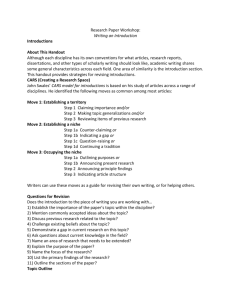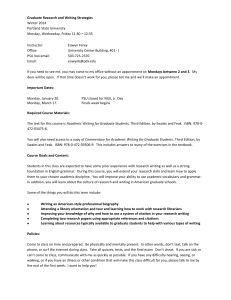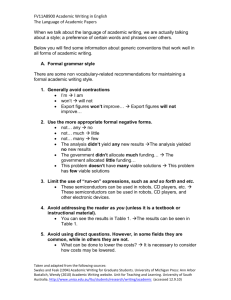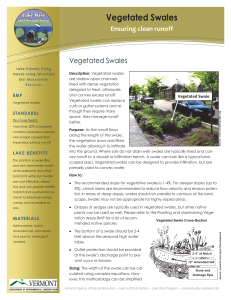PARTS OF THE RESEARCH PAPER
advertisement
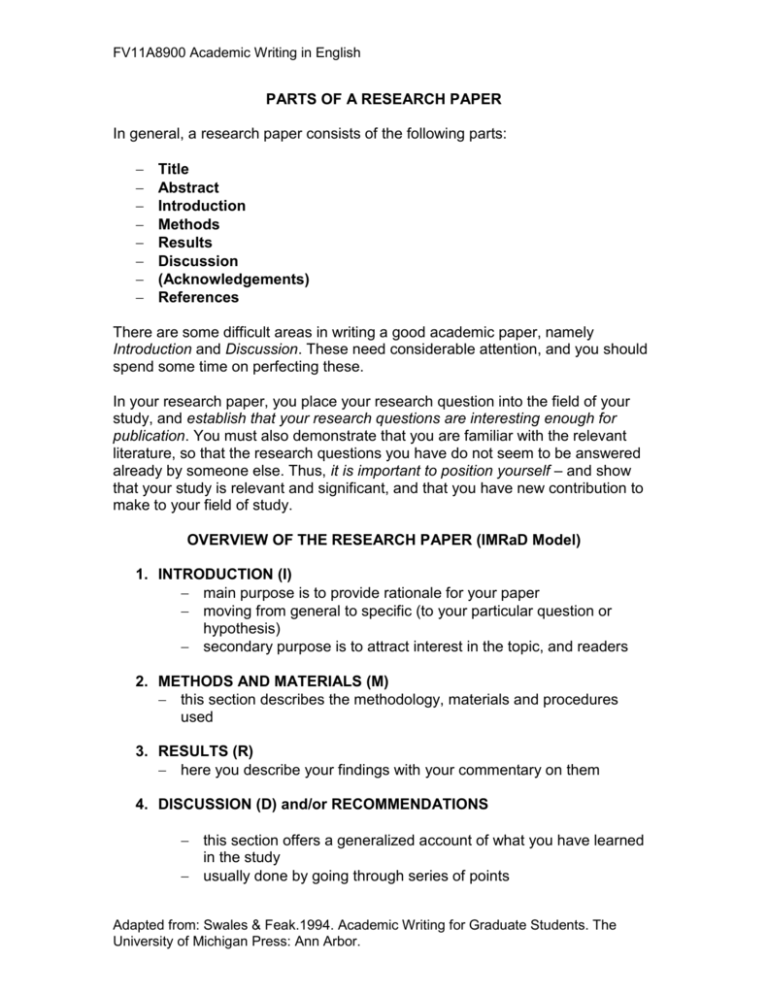
FV11A8900 Academic Writing in English PARTS OF A RESEARCH PAPER In general, a research paper consists of the following parts: Title Abstract Introduction Methods Results Discussion (Acknowledgements) References There are some difficult areas in writing a good academic paper, namely Introduction and Discussion. These need considerable attention, and you should spend some time on perfecting these. In your research paper, you place your research question into the field of your study, and establish that your research questions are interesting enough for publication. You must also demonstrate that you are familiar with the relevant literature, so that the research questions you have do not seem to be answered already by someone else. Thus, it is important to position yourself – and show that your study is relevant and significant, and that you have new contribution to make to your field of study. OVERVIEW OF THE RESEARCH PAPER (IMRaD Model) 1. INTRODUCTION (I) main purpose is to provide rationale for your paper moving from general to specific (to your particular question or hypothesis) secondary purpose is to attract interest in the topic, and readers 2. METHODS AND MATERIALS (M) this section describes the methodology, materials and procedures used 3. RESULTS (R) here you describe your findings with your commentary on them 4. DISCUSSION (D) and/or RECOMMENDATIONS this section offers a generalized account of what you have learned in the study usually done by going through series of points Adapted from: Swales & Feak.1994. Academic Writing for Graduate Students. The University of Michigan Press: Ann Arbor. FV11A8900 Academic Writing in English suggestions and recommendations for future research or possible practical uses for the results. 5. CONCLUSION not always necessary; sometimes covered in the discussion section. In this course, you are not required to do much research, so Methods and Materials, and Results sections are not entirely relevant. However, you are required to bring forward your main points of the literature that you have studied for your paper in the main section. For more information on the structure of research papers, please go to the following URLs: http://sana.tkk.fi/awe/style/reporting/sections/index.html http://www.experiment-resources.com/parts-of-a-research-paper.html http://www.umuc.edu/ewc/onlineguide/chapter4/chapter4-13.shtml Let’s look at the Introduction section more closely. CREATING A RESEARCH SPACE (CARS model) Writing introductions can be slow and difficult process both for native and nonnative speakers of English. We use the CARS (Create-a-Research-Space) model in the AWE course. In this Introduction pattern the other research in your field is primary and your own work is secondary. So, you have to position yourself within your own field of study. There are three moves in this model: Move 1 Establishing a research territory a. by showing that the general research area is important, central, interesting, problematic, or relevant in some way (optional) b. by introducing and reviewing items of previous research in the area (obligatory) Move 2 Establishing a niche1 a. by indicating a gap in the previous research, or by extending previous knowledge in some way (obligatory) Move 3 Occupying the niche a. by outlining purposes or stating the nature of the present research (obligatory) b. by listing research questions or hypotheses (PISF2) 1 In ecology, a niche is a particular microenvironment where a particular organism can thrive. In our case, a niche is a context where a particular piece of research makes particularly good sense. Adapted from: Swales & Feak.1994. Academic Writing for Graduate Students. The University of Michigan Press: Ann Arbor. FV11A8900 Academic Writing in English c. by announcing principal findings (PISF) d. by stating the value of the present research (PISF) e. by indicating the structure of the RP (PISF) More detailed information on the CARS model can be found at the following URL: http://sana.tkk.fi/awe/style/reporting/sections/intros/index.html You might not be able to follow the CARS model to the point, but at least in your Introduction you should introduce or review what has been written and researched in your field previously. Then you show what your paper is adding to the research field, and finally outline your main points in the paper. More information about writing introductions in general can be found at the following URLs: http://www2.hmc.edu/~alves/intros.html http://www.unc.edu/depts/wcweb/handouts/introductions.html ***This one is particularly helpful. 2 PISF = probable in some fields, but rare in others. Adapted from: Swales & Feak.1994. Academic Writing for Graduate Students. The University of Michigan Press: Ann Arbor.

